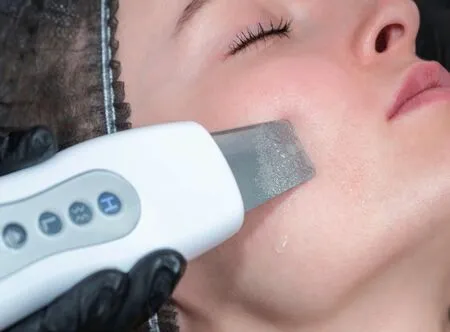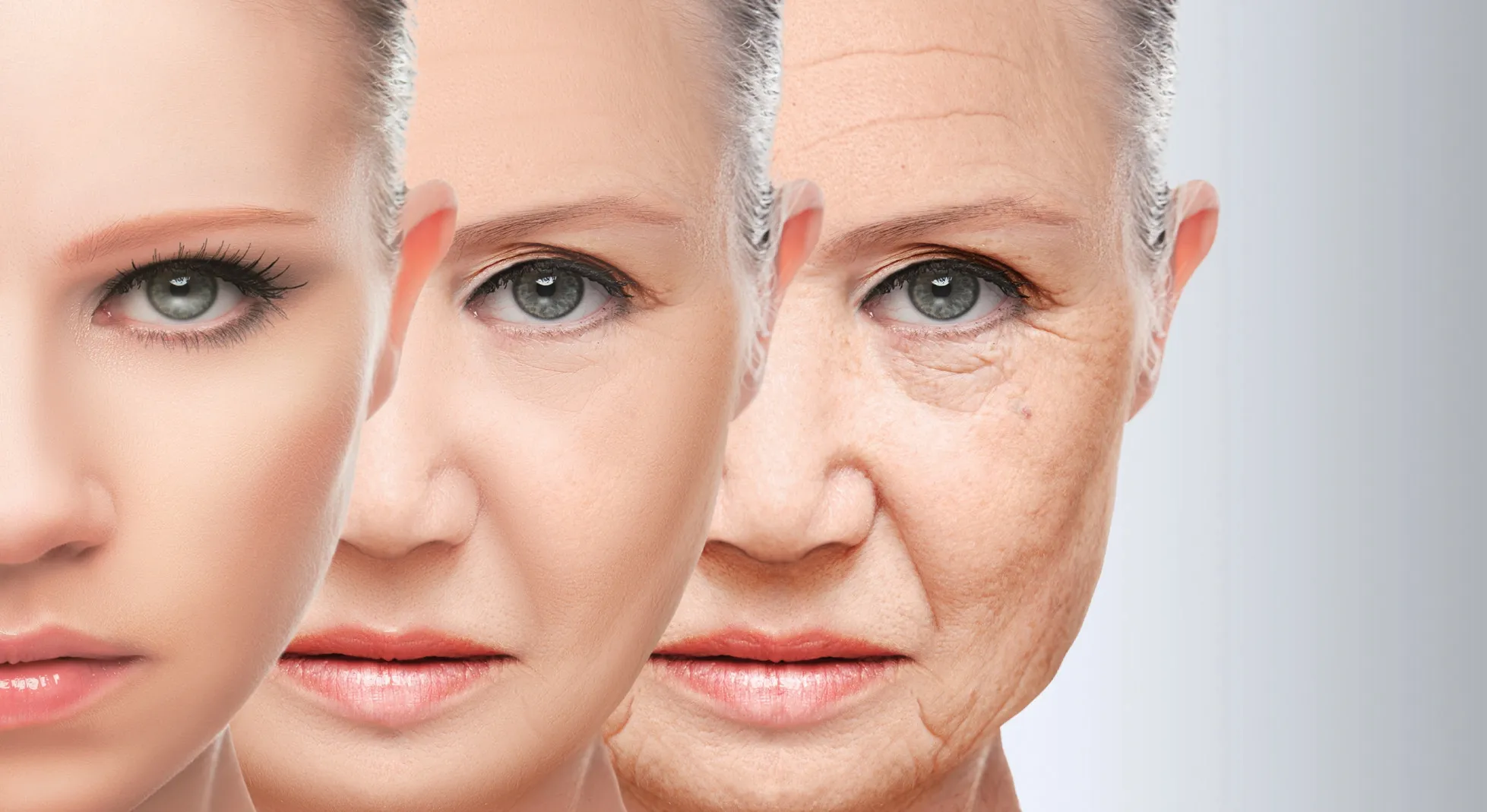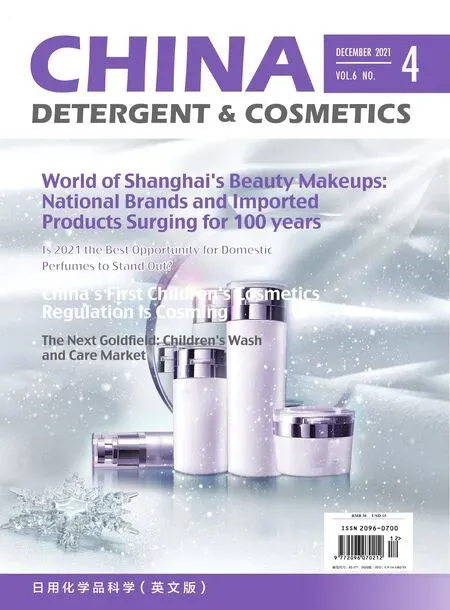Mechanism of Novel Natural Products Maintaining Skin
Chen Min,Pang Ying,Pan Sha
Hangzhou CN Formulator Technology Co.,Ltd.,China
Abstract The inducement of skin carbonylation was briefly introduced,then the mechanism of protein carbonylation from skin was discussed and adverse reactions to human skin were analyzed.Finally,according to the mechanism of protein carbonylation and the degradation mode,the proposed solutions were as follows:diglucosyl gallic acid,Hibiscus sabdariffa flower extract;Prunus cerasus flower extract can reduce the protein carbonylation level of skin by reducing t ROS and Phaeodactylum tricornutum extract can improve the activity of 20s enzyme and accelerating the hydrolysis level of carbonyl protein,to achieve the perfect repair of skin.
Key words protein carbonylation;skin maintian;diglucosyl gallic acid;hibiscus sabdariffa flower extract
With the rapid development of economy,the trivial life,the noise of the city,the pollution of environment,the fierce competition and the alienation of interpersonal relations,modern human are under heavy pressure while enjoying the material comforts.According to Statistic Brain Research Institute,77% of people have experienced physical changes caused by stress,48% of people are more stressed than five years ago[1].Chronic stress can cause skin discomfort:decreased of water content and transparency,increased transepidermal water loss.In the end,it will make the skin appear dry,dark yellow,dull and reduce the barrier function.The reason for the above phenomenon is that the skin is damaged by oxidative stress.
Oxidative stress refers to the excessive production of highly active molecules such as reactive oxygen species under pathological conditions.The degree of oxidation exceeds the ability of oxide removal.The disorders in the oxidative system and antioxidative system leads to tissue damage[2].
Skin is one of the main targets of oxidative stress,which is produced by endogenic reaction and exposure to external stimuli[3].ROS in the skin can change the proteins in the cellular of the skin.If it can’t be fully controlled by the skin antioxidant defense system,it will lead to the production of carbonylated proteins in the skin and cause skin damage[4].
Protein carbonylation means that the amino or imino groups in the side chains of amino acid residues are attacked by reactive oxygen species and finally transformed into aldehyde groups,and release NH3+,It is generally understood that hydroxyl radical can directly act on peptide bond,and peptide bond is broken which leads to the formation of carbonyl functional groups at the break.The amino acids in protein side chain are attacked by free radical,and the content of carbonyl protein will be greatly increased after oxidative modification.

Carbonylation is essentially different from the popular glycation in reaction mechanism:glycation is a non-enzymatic process:free sugars are added to proteins in the form of covalent bonds.This process is not controlled by enzymes,so it is a nonenzymatic reaction.Glycation occurs spontaneously in the blood.Glycation irreversibly binds sugars or sugar degradation products to proteins.It’s called Maillard reaction.In addition,glycation is a process that destroys proteins:it reduces the stability and functionality of proteins.
1 Inducement of skin carbonylation
External environmental factors (UV,blue light,dry environment,cigarette smoke,PM2.5,lifestyle,etc.) will cause protein carbonylation reaction[5-8].
In autumn and winter,due to the dry environment,the carbonyl protein content of skin will be higher than that in summer[5].
Exposure to sunlight,especially to UV,accelerates protein carbonylation[6],and UV is widely considered to be a factor leading to skin damage and cancer[9].Recently,visible blue light with a longer wavelength than UV has also been considered as a source of oxidative stress in skin cells[10].
Cigarette smoke is rich in reactive oxygen species(ROS),which will accelerate the carbonylation of proteins[7].Protein carbonylation includes aldehydes and ketones formed by different mechanisms connected to different positions of protein[11-14].The level of carbonylated protein in smokers is higher than that in non-smokers[15].
Organic chemicals carried by PM2.5,such as polycyclic aromatic hydrocarbons (PAHs),are highly lipophilic and easy to penetrate the skin[16].PAHs are effective activators of aromatic hydrocarbon receptor (AHR).AHR is an important receptor.PAHs activated AHR can up regulate the expression of cytochrome P450 involved in exogenous metabolism[17],promote the production of intracellular ROS,and lead to protein carbonylation[8].
Carbonylated proteins in skin mainly exist in epidermis and dermis,and the content of carbonylated proteins in epidermis is higher than that in dermis[18].This is because the epidermal layer of the skin is continuously exposed to the oxidative environment and unsaturated liposome environment secreted by sebaceous glands,creating favorable conditions for the continuous generation of active aldehyde compounds[19].
2 Effects of carbonylated proteins on skin
Protein carbonylation is caused by the oxidative cleavage of protein,the direct oxidation of amino acid residues or the introduction of carbonyl groups by the reaction with aldehydes produced by lipid peroxidation[20].Protein carbonylation marks the ROS mediated skin changes,and it’s related to changes in skin characteristics:such as mechanical properties[21];decreasing of water content and increasing of transepidermal water loss[22];dark yellow and dull skin[23];decreasing skin transparency[24].At the same time,increased levels of carbonylated proteins can lead to inflammatory skin diseases such as psoriasis and dermatitis[25].
There are some misunderstandings in the traditional cognition of dark and yellow skin:on the one hand,it is considered that dark yellow and skin is the front characteristic of black skin.In fact,their mechanisms are quite different:black skin is related to melanin in the skin:melanin is produced by melanosomes of melanocytes.According to skin physiology,the main factor determining the depth of skin color is the content and distribution of skin melanin.Melanocytes located in the basal layer of the skin.The secretion of melanin by melanocytes is an extremely complex biological process,which involves the occurrence of melanocytes,dendrites,melanosome maturation and transport,and is closely related to keratinocytes and extracellular matrix[26].On the other hand,it is considered that the dark and yellow skin is caused by protein glycation:the glycation of protein is the combination of the carbonylation of reducing sugar (such as glucose or fructose) with protein in non-enzymatic reaction to form glycated protein[27].In fact,the dark and yellow skin caused by protein carbonylation is much higher than that of skin glycation[28].
When the protein in the skin is damaged,there are three treatments:repairing,decomposition by the protein degradation system and accumulation.Protein carbonylation is likely to lose its original biological function.Because carbonylation is an irreversible reaction,protein carbonylation cannot be repaired and is usually transported directly to the protein degradation system for degradation.However,when carbonylated proteins are generated too much or proteasome activity is reduced which cannot degrade carbonylated proteins,carbonylated proteins will accumulate in the skin,resulting in skin damage[29,30].
3 Protein degradation system
The main mechanism responsible for protein maintenance is the ubiquitin proteasome system(UPS).UPS has two main pathways:one is the degradation pathway of ATP dependent 26S proteasome ubiquitination,and the other is the degradation pathway catalyzed by ATP independent 20S proteasome;20S proteasome can exist alone or form 26S proteasome with 19S regulatory complex[31].20S proteasome consists of 28 subunits arranged into 4 stacked rings.The two outer rings are made of α subunit composition and the two inner rings are made of β subunit composition.The subunit has proteolytic activity.The 20S proteasome is the only protein that can recognize and degrade damaged or misfolded proteins,while the 26S proteasome degrades natural folded and functional proteins in the way of ATP and ubiquitination[32].The 20S proteasome is the main protein hydrolysis system for removing carbonylated proteins.Compared with the degradation of natural proteins,the degradation of oxidative damaged proteins does not require ATP or ubiquitination.Therefore,increasing the ubiquitination system has little effect on the degradation of carbonylated proteins[29,30].Protein carbonylation can lead to the opening and denaturation of protein side chains,thus increasing its hydrophobic surface.These hydrophobic fragments just provide recognition sites for 20S proteasome[33].Only slightly carbonylated proteins can be degraded by proteasome,while over carbonylated and cross-linked proteins cannot be degraded by proteasome,and they have characteristics of anti-proteasome hydrolysis[34].It shows that protein carbonylation leads to skin discomfort which needs to be repaired in time.Otherwise,Carbonylated proteins accumulate excessively in the skin and will be irreversible.
4 Treatment to reduce protein carbonylation
There are two main ways to reduce protein carbonylation:reducing the content of ROS in the skin to prevent the carbonylation of proteins;improving the activity of 20S proteasome and accelerate the degradation of carbonylated proteins.
Natural active products have the characteristics of high efficiency and safety,which contain enormous developmental potential.
Tara is the evergreen spiny shrub or small tree,native to northwest South America and rich in Peru.There are generous gallic acids in Tara pods[35],which have antioxidant properties and can reduce the content of ROS in skin[36,37].However,it has defects such as unstable structure and poor water solubility,so the diglucosyl gallic acid obtained by biological modification not only improves its disadvantages,but also maintains the original antioxidant performance[38].
Hibiscus sabdariffa flower extract has a long history in cosmetics,as it is rich in phenolic acids,flavonoids,anthocyanins and organic acids (citric acid,hydroxycitric acid,hibiscus,tartaric acid,malic acid and ascorbic acid).Prunus cerasus flower extract is rich in caffeoyl glucoside.These antioxidants can reduce the content of ROS in the skin[39-42].
Phaeodactylum tricornutum extract has the ability of improving the activity of 20S proteasome,which can reduce skin hydroxylated protein.This is because it is rich in polyunsaturated fatty acids,which can enhance the activity of 20S proteasome to degrade carbonylated proteins and repair skin[43,44].
According to above mechanism,combined with the action mechanism of Phaeodactylum tricornutum extract and Tara extract,the Phaeodactylum tricornutum/Tara composite product is developed,which can synergistically repair the skin[45].
5 Conclusion
The adverse changes of protein carbonylation on human skin are researched from the mechanism of protein carbonylation.It is creatively proposed that the dark and yellow skin is the result of protein carbonylation accumulation,which is different from the traditional whitening mechanism.Then,according to the mechanism of protein carbonylation,the perfect repairing method of skin are proposed:diglucosylgallic acid,Hibiscus sabdariffa flower extract and Prunus cerasus flower extract can reduce ROS to prevent the formation of carbonylated proteins and Phaeodactylum tricornutum extract can enhance the activity of 20S proteasome to accelerate the hydrolysis level of carbonylated protein.

 China Detergent & Cosmetics2021年4期
China Detergent & Cosmetics2021年4期
- China Detergent & Cosmetics的其它文章
- Progress of Study on Cistanche Application in Cosmetics
- Experimental Method Of Cosmetics Human Efficacy Evaluation—Delaying Skin Aging Efficacy
- Research Progress and Cosmetic Application of Fibronectin
- Discussion on the Efficacy Evaluation Method of Skin Repair Cosmetics
- Study on Synergistic Effect and Mechanism of Sunscreen Bemt and Mbbt
- Interpretation of China’s Cross-border E-commerce Regulation
